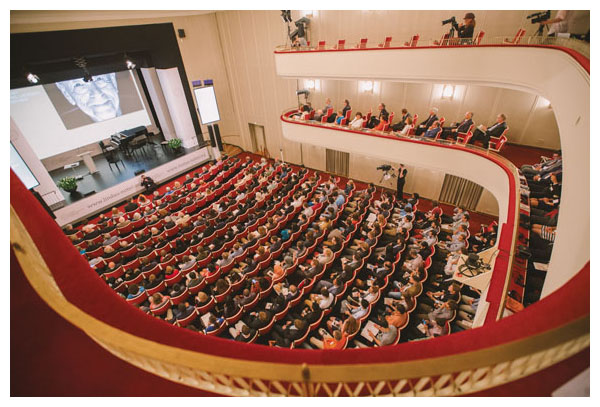Dispatches from Lindau
By Brian Malow
Nobel laureates mentor young scientists at their annual meeting in Lindau, Germany.
Nobel laureates mentor young scientists at their annual meeting in Lindau, Germany.

DOI: 10.1511/2016.122.262
One year ago, PhD student Zara Bagdasarian was driving through Germany on her way to Italy and was thrilled when she saw a road sign for Lindau. “I was like, ‘Oh! This is the place where the Nobel laureates meet up! I want to be there!’” To Bagdasarian, an experimental neutrino physicist from the former Soviet Republic of Georgia, Lindau seemed a distant dream at the time. “I really didn’t think that I would be here in one year.”
This summer, she was one of 400 young physicists from 80 countries who spent a week on the picturesque island along the shores of Lake Constance in Bavaria, attending the Lindau Nobel Laureate Meeting. Since 1951, Nobel laureates, hosted by the Lindau Foundation, have convened once a year to meet the next generation of leading scientists from all over the world. Bagdasarian, now a postdoctoral researcher at the Jülich Research Center in Germany, was one of the lucky few students and postdocs selected to participate in several days of lectures, master classes, panel discussions, and an invited poster session.

She is currently collaborating on the “ short distance neutrino oscillations with Borexino (SOX) experiment,” which builds upon recent research demonstrating that neutrinos oscillate, or change identities, and therefore have mass. Conducted using the Borexino detector at the Gran Sasso National Laboratory in Italy, the SOX experiment aims to detect even more enigmatic versions of the particles, known as sterile neutrinos. If found, sterile neutrinos could open the door to a vast realm of new physics that possibly explains dark matter or mediates new kinds of interactions via dark radiation.
On the first day of the meeting, Bagdasarian discussed her research with Arthur B. McDonald of Queen's University, Canada, and Takaaki Kajita from the University of Tokyo, who shared the 2015 Nobel Prize in Physics for their discovery of neutrino oscillations—the work that paved the way for her own investigations. “I got the approval of both Nobel Laureates today that it’s an important experiment,” she said, beaming. Even more than that validation, what struck her was how nice and humble McDonald and Kajita were. In his lecture that afternoon, McDonald had shown a slide with the names of all 130 of his collaborators.
“You need a lot of people collaborating to make projects like these huge neutrino detectors,” Bagdasarian said. “No single country can build something this big. So it’s really nice to see how everybody can work together so well.”
Bagdasarian’s experience is happily typical for the young attendees of the meeting. Katarzyna Tych, a British protein biophysicist working at the Technical University of Munich, hoped to meet Ada Yonath, the first Israeli woman to win the Nobel Prize in 2009 for her pioneering work on the structure of the ribosome. “I had dinner with her last night in a very small group, where we could honestly talk in a relaxed way for a few hours, and that was mind-blowing. These people are at the top of their fields, explaining things to us as if it’s just normal to talk to us,” Tych said.
With 400 young scientists from around the world interacting freely, each is a node on a temporary neural net of 80,200 possible peer-to-peer connections—not that anyone could hope to interact with more than a tiny fraction of the other guests in the course of the fast-paced week. In between lectures and sessions, over lunches and coffee, they excitedly share stories of Nobel encounters. This year, because of his enthusiasm, his humor, and his eagerness to engage, many of the stories are about William D. Phillips, winner of the Nobel Prize in Physics in 1997 for his contributions to laser-cooling atoms. He must exist in a state of quantum superposition, because he appears to be all places at once, interacting with an impossible number of attendees. Klaus von Klitzing, who was awarded the 1985 Nobel Prize in Physics for discovering the integer quantum Hall effect, inspired a flurry of Facebook posts when he casually produced his Nobel Prize—the gold medal itself—and allowed a gaggle of young physicists to hold it, pass it around, and pose for pictures with it.
The meeting has come a long way since the first gathering of just seven laureates, 65 years ago, when it began as a European initiative of postwar reconciliation among scientists. In 1953, the decision was made to invite students and postdocs to participate, thereby refocusing the meeting on future generations. In a word, Lindau has become about mentorship.
Science conferences traditionally emphasize a top-down structure, with a handful of experts lecturing to a large, politely listening audience. Once this meeting expanded to be more inclusive, it evolved a different tradition, one that emphasizes the breaking down of barriers between the renowned senior researchers and the young upstarts, who traditionally either wouldn’t be invited to other workshops or who would be shunted into poster sessions at large meetings.
To be sure, there are auditorium lectures and panel discussions. Videos are available on the Lindau website, where anyone can watch George Smoot, 2006 Nobel laureate in Physics for his work on the cosmic microwave background radiation, speaking on gravitational waves, or Dan Schechtman, 2011 Nobel laureate in Chemistry for the discovery of quasicrystals, describing the science and beauty of soap bubbles. But the big-room lectures are only a secondary aspect to what goes on at Lindau.

“The most important thing is to see people who are doing good science: what kind of standards they have, how they figure out what kind of problems to work on, how they check their work—and how they interact with their colleagues,” Smoot said. “The real point of that is to develop societal skills on how you actually operate in a world in which there’s big science and big commercial activities—where you’re competing but you’re also collaborating because you all live on the same Earth.”
The program, based on the principle of dialogue at Lindau, is enabled by a series of lectures and master classes. The master classes are much smaller than the plenary lectures and are composed of only a small group of invited young researchers; participants present their own research and receive feedback from Nobel laureates and their peers. Free and frank conversations are furthered by intimate discussion sessions chaired by a laureate and are off-limits to anyone but the young scientists.
“This is my favorite part of the day because we get to ask them [the laureates] anything from the most remote physical question to what they think about collaboration, anything. There is no format,” says Gabriela Barreto Lemos, a Brazilian scientist doing her postdoc at the Institute for Quantum Optics and Quantum Information in Vienna. “And they just respond.”
Dave Wineland, who was awarded the Nobel Prize in Physics in 2012 for his work on controlling quantum systems, wants to connect the laureates and the attendees on a deeper level: “I feel like one of my main goals is to convince the students that I’m not really that special. A lot of students put us on a pretty high pedestal and I think, certainly in my own case, I’m not any smarter than most of these students here. I am a pretty normal person. I hope the one value I can have in interacting with the students is to convince them—maybe they aren’t going to win a Nobel Prize, but they certainly can be successful in their careers and the line of research they might choose.”
But it’s not just about forwarding science for its own sake. A motivation to serve and a view of science operating in the world is built into the DNA of the Nobel Prizes. Alfred Nobel, a noted pacifist whose wealth came from his invention of dynamite, endowed the bulk of his fortune to fund the prizes expressly for those who “have conferred the greatest benefit to mankind.” Using the collective power of this international brain trust—this expanding neural net—the Lindau meetings are increasingly becoming a source of social activism. In past years, meeting participants have called for acceptance of a universal right to education, and for efforts to reverse public opinion on genetically modified organisms. Since last year, 72 Nobel laureates have signed a declaration urging that climate change be taken more seriously. To wrap up this year’s meeting, delegates were invited to attend a panel discussion on the future of scientific education focused on crucial aspects of the support of young scientists.
The spirit of giving back demonstrated by the laureates both in their commitment to mentorship and in their social awareness is emulated by many of the young attendees, including Temitope Oladele of Nigeria, who studies optical systems and has made it her personal goal to improve access to global information in her country.
From the first day, the message of the meeting was made clear: intergenerational dialogue is important in order to ensure that the decisions of today take into account the consequences for future generations. Wolfgang Schürer, former chairman of the board of the Lindau Foundation, reinforced this future-looking tone: “During the discussions, if you spot a vacant chair, don’t think it is empty. Imagine the chair is occupied by a member of a generation yet-to-come and think what he or she would like discussed.”
Click "American Scientist" to access home page
American Scientist Comments and Discussion
To discuss our articles or comment on them, please share them and tag American Scientist on social media platforms. Here are links to our profiles on Twitter, Facebook, and LinkedIn.
If we re-share your post, we will moderate comments/discussion following our comments policy.